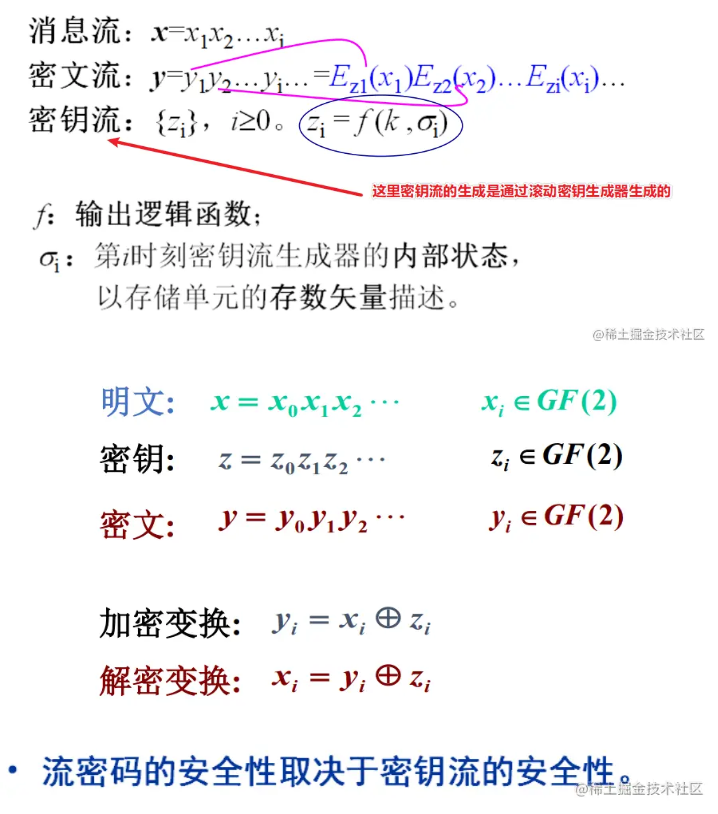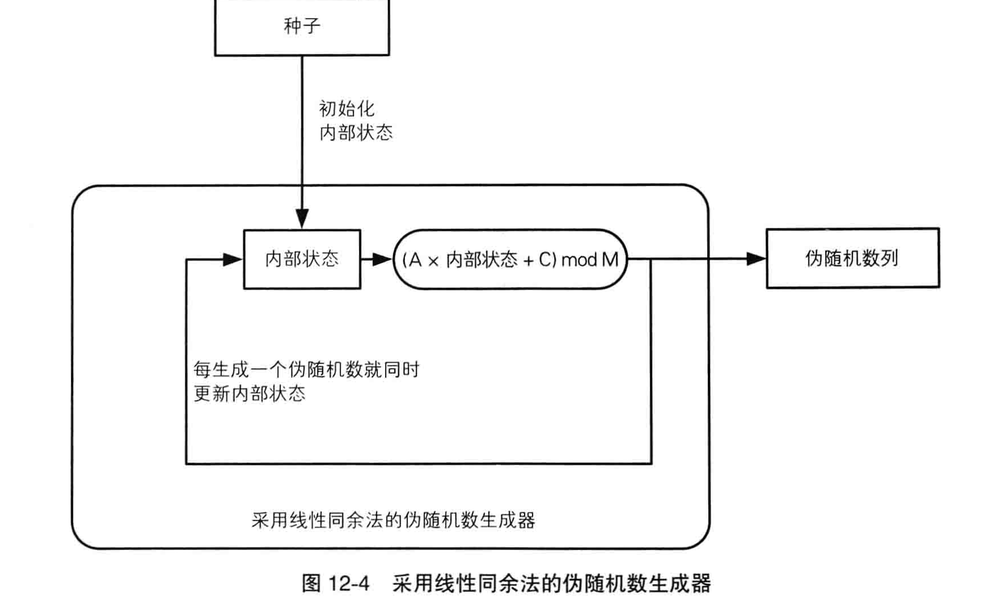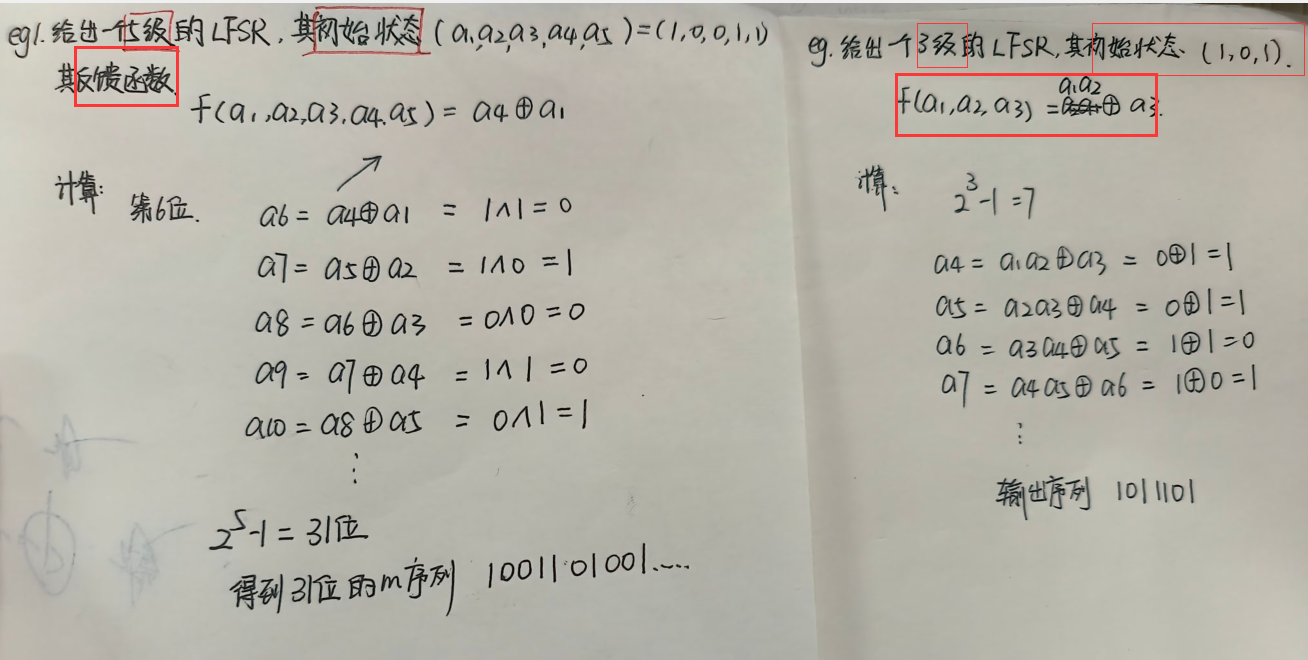流密码
流密码(Stream cipher)
流密码 | Lazzaro (lazzzaro.github.io)
密码学复习——第二章(流密码)-阿里云开发者社区 (aliyun.com)
(144条消息) 流密码(一次一密、流密码/序列密码、LFSR、RC4)_Yongliang Xu的博客-CSDN博客
- 明文逐位与密钥流进行异或运算,生成密文流
- 又称序列密码
- 对称加密算法,加密和解密双方使用相同伪随机加密数据流(pseudo-random stream)作为密钥
- 流密码的安全性依赖于生成高质量的密钥流。
- 密钥流应该是伪随机的,不可预测的,并且对于同一个密钥,不应该重复出现。
二元加法流密码
一种基于二进制加法运算的流密码算法。它使用一个密钥流和明文流进行逐位的二进制加法运算,生成密文流
一次一密(one-time pad)
-
又称Vernam加密法
-
将明文与随机生成的密钥进行异或运算来实现加密和解密
-
密钥:与明文等长、完全随机、只使用一次,并且发送者和接收者在事先共享同一密钥。
-
不能提供完整性验证和认证
一次一密的密钥长度和明文一样长,流密码不是,需要种子密钥通过密钥生成器产生密钥流
多次一密(Many Time Pad Attack)
多次一密攻击的关键在于密钥重复使用。由于密钥序列在多次加密中重复使用,攻击者可以通过异或运算的性质,推断出密钥流的一部分或全部内容,从而破解密钥和解密密文。
异或运算性质
这个攻击的原理是 ,而通过 可以分析出 ,因此 不再安全。
两个密文的异或,就等于对应明文的异或,可以通过频率分析,来破译这些密文。
ascii表
ascii 码表在 Linux 下可以通过 man ascii 指令查看。它的性质有:
0x20是空格。 低于0x20的,全部是起特殊用途的字符;0x20~0x7E的,是可打印字符。0x30~0x39是数字0,1,2...9。0x41~0x5A是大写字母A-Z;0x61~0x7A是小写字母a-z
小写字母 ⊕ 空格,会得到对应的大写字母;大写字母 ⊕ 空格,会得到小写字母!所以,如果x ⊕ y得到一个英文字母,那么中的某一个有很大概率是空格
例题–[AFCTF2018]你听过一次一密么?
题目
25030206463d3d393131555f7f1d061d4052111a19544e2e5d
0f020606150f203f307f5c0a7f24070747130e16545000035d
1203075429152a7020365c167f390f1013170b1006481e1314
0f4610170e1e2235787f7853372c0f065752111b15454e0e09
081543000e1e6f3f3a3348533a270d064a02111a1b5f4e0a18
0909075412132e247436425332281a1c561f04071d520f0b11
4116111b101e2170203011113a69001b475206011552050219
041006064612297020375453342c17545a01451811411a470e
021311114a5b0335207f7c167f22001b44520c15544801125d
06140611460c26243c7f5c167f3d015446010053005907145d
0f05110d160f263f3a7f4210372c03111313090415481d49攻击击过程显而易见:对于每一条密文c1,拿去异或其他所有密文。然后去数每一列有多少个英文字符,作为c1在这一位是空格的评分。
上面的事情做完时候,依据评分从大到小排序,依次利用 “某个明文的某一位是空格” 这种信息恢复出所有明文的那一列。如果产生冲突,则舍弃掉评分小的。
脚本:
#脚本1
import Crypto.Util.strxor as xo
import libnum, codecs, numpy as np
def isChr(x):
if ord('a') <= x and x <= ord('z'): return True
if ord('A') <= x and x <= ord('Z'): return True
return False
def infer(index, pos):
if msg[index, pos] != 0:
return
msg[index, pos] = ord(' ')
for x in range(len(c)):
if x != index:
msg[x][pos] = xo.strxor(c[x], c[index])[pos] ^ ord(' ')
def know(index, pos, ch):
msg[index, pos] = ord(ch)
for x in range(len(c)):
if x != index:
msg[x][pos] = xo.strxor(c[x], c[index])[pos] ^ ord(ch)
dat = []
def getSpace():
for index, x in enumerate(c):
res = [xo.strxor(x, y) for y in c if x!=y]
f = lambda pos: len(list(filter(isChr, [s[pos] for s in res])))
cnt = [f(pos) for pos in range(len(x))]
for pos in range(len(x)):
dat.append((f(pos), index, pos))
c = [codecs.decode(x.strip().encode(), 'hex') for x in open('Problem.txt', 'r').readlines()]
msg = np.zeros([len(c), len(c[0])], dtype=int)
getSpace()
dat = sorted(dat)[::-1]
for w, index, pos in dat:
infer(index, pos)
know(10, 21, 'y')
know(8, 14, 'n')
print('\n'.join([''.join([chr(c) for c in x]) for x in msg]))
key = xo.strxor(c[0], ''.join([chr(c) for c in msg[0]]).encode())
print(key)#脚本2
#!/usr/bin/python
## OTP - Recovering the private key from a set of messages that were encrypted w/ the same private key (Many time pad attack) - crypto100-many_time_secret @ alexctf 2017
# Original code by jwomers: https://github.com/Jwomers/many-time-pad-attack/blob/master/attack.py)
import string
import collections
import sets, sys
# 11 unknown ciphertexts (in hex format), all encrpyted with the same key
c1='daaa4b4e8c996dc786889cd63bc4df4d1e7dc6f3f0b7a0b61ad48811f6f7c9bfabd7083c53ba54'
c2='c5a342468c8c7a88999a9dd623c0cc4b0f7c829acaf8f3ac13c78300b3b1c7a3ef8e193840bb'
c3='dda342458c897a8285df879e3285ce511e7c8d9afff9b7ff15de8a16b394c7bdab920e7946a05e9941d8308e'
c4='d9b05b4cd5ce7c8f938bd39e24d0df191d7694dfeaf8bfbb56e28900e1b8dff1bb985c2d5aa154'
c5='d9aa4b00c88b7fc79d99d38223c08d54146b88d3f0f0f38c03df8d52f0bfc1bda3d7133712a55e9948c32c8a'
c6='c4b60e46c9827cc79e9698936bd1c55c5b6e87c8f0febdb856fe8052e4bfc9a5efbe5c3f57ad4b9944de34'
c7='d9aa5700da817f94d29e81936bc4c1555b7b94d5f5f2bdff37df8252ffbecfb9bbd7152a12bc4fc00ad7229090'
c8='c4e24645cd9c28939a86d3982ac8c819086989d1fbf9f39e18d5c601fbb6dab4ef9e12795bbc549959d9229090'
c9='d9aa4b598c80698a97df879e2ec08d5b1e7f89c8fbb7beba56f0c619fdb2c4bdef8313795fa149dc0ad4228f'
c10='cce25d48d98a6c8280df909926c0de19143983c8befab6ff21d99f52e4b2daa5ef83143647e854d60ad5269c87'
c11='d9aa4b598c85668885df9d993f85e419107783cdbee3bbba1391b11afcf7c3bfaa805c2d5aad42995ede2cdd82977244'
ciphers = [c1, c2, c3, c4, c5, c6, c7, c8, c9, c10, c11]
# The target ciphertext we want to crack
# XORs two string
def strxor(a, b): # xor two strings (trims the longer input)
return "".join([chr(ord(x) ^ ord(y)) for (x, y) in zip(a, b)])
def target_fix(target_cipher):
print '-------begin-------'
# To store the final key
final_key = [None]*150
# To store the positions we know are broken
known_key_positions = set()
# For each ciphertext
for current_index, ciphertext in enumerate(ciphers):
counter = collections.Counter()
# for each other ciphertext
for index, ciphertext2 in enumerate(ciphers):
if current_index != index: # don't xor a ciphertext with itself
for indexOfChar, char in enumerate(strxor(ciphertext.decode('hex'), ciphertext2.decode('hex'))): # Xor the two ciphertexts
# If a character in the xored result is a alphanumeric character, it means there was probably a space character in one of the plaintexts (we don't know which one)
if char in string.printable and char.isalpha(): counter[indexOfChar] += 1 # Increment the counter at this index
knownSpaceIndexes = []
# Loop through all positions where a space character was possible in the current_index cipher
for ind, val in counter.items():
# If a space was found at least 7 times at this index out of the 9 possible XORS, then the space character was likely from the current_index cipher!
if val >= 7: knownSpaceIndexes.append(ind)
#print knownSpaceIndexes # Shows all the positions where we now know the key!
# Now Xor the current_index with spaces, and at the knownSpaceIndexes positions we get the key back!
xor_with_spaces = strxor(ciphertext.decode('hex'),' '*150)
for index in knownSpaceIndexes:
# Store the key's value at the correct position
final_key[index] = xor_with_spaces[index].encode('hex')
# Record that we known the key at this position
known_key_positions.add(index)
# Construct a hex key from the currently known key, adding in '00' hex chars where we do not know (to make a complete hex string)
final_key_hex = ''.join([val if val is not None else '00' for val in final_key])
# Xor the currently known key with the target cipher
output = strxor(target_cipher.decode('hex'),final_key_hex.decode('hex'))
print "Fix this sentence:"
print ''.join([char if index in known_key_positions else '*' for index, char in enumerate(output)])+"\n"
# WAIT.. MANUAL STEP HERE
# This output are printing a * if that character is not known yet
# fix the missing characters like this: "Let*M**k*ow if *o{*a" = "cure, Let Me know if you a"
# if is too hard, change the target_cipher to another one and try again
# and we have our key to fix the entire text!
#sys.exit(0) #comment and continue if u got a good key
print '------end------'
for i in ciphers:
target_fix(i)
伪随机密钥流
伪随机序列
伪随机序列也就是,即使截获其中一段,也无法推测后面是什么。(只能要求截获比周期短的一段密钥流时不会泄露更多信息, 这样的序列称为伪随机序列。)
伪随机数生成器
线性同余生成器 / 线性同余方法(LCG)
线性同余方法(LCG)是个产生伪随机数的方法
LCG的性能和随机性取决于选取的参数。如果选择恰当的参数,LCG可以生成长周期和均匀分布的伪随机数序列。然而,不恰当的参数选择可能导致序列的周期较短或者存在可预测的模式,从而影响其随机性和安全性
LCG的周期最大为 ,但大部分情况都会少于 。要令LCG达到最大周期,应符合以下条件:
- 互质;
- 的所有质因数都能整除 ;
- 若 是4的倍数, 也是;
- 都比 小;
- 是正整数。
from functools import reduce
from math import gcd
from Crypto.Util.number import *
def egcd(a, b):
if a == 0:
return (b, 0, 1)
else:
g, y, x = egcd(b % a, a)
return (g, x - (b // a) * y, y)
def modinv(a, m):
g, x, y = egcd(a, m)
if g != 1:
raise Exception('modular inverse does not exist')
else:
return x % m
def crack_unknown_increment(states, modulus, multiplier):
increment = (states[1] - states[0]*multiplier) % modulus
return modulus, multiplier, increment
def crack_unknown_multiplier(states, modulus):
multiplier = (states[2] - states[1]) * modinv(states[1] - states[0], modulus) % modulus
return crack_unknown_increment(states, modulus, multiplier)
def crack_unknown_modulus(states):
diffs = [s1 - s0 for s0, s1 in zip(states, states[1:])]
zeroes = [t2*t0 - t1*t1 for t0, t1, t2 in zip(diffs, diffs[1:], diffs[2:])]
modulus = abs(reduce(gcd, zeroes))
return crack_unknown_multiplier(states, modulus)
# N[i+1] = (A*N[i]+B) % M
# A,B,N均未知
sequence = []
modulus, multiplier, increment = crack_unknown_modulus(sequence)
print('A = '+str(multiplier))
print('B = '+str(increment))
print('N = '+str(modulus))
线性反馈移位寄存器(Linear Feedback Shift Register,简称LFSR)
用于生成一个伪随机的比特序列,常用于加密、编码、通信等领域。
移位寄存器是流密码产生密钥流的一个主要组成部分,GF(2)上一个n级反馈移位寄存器由n个二元存储器与一个反馈函数组成。
移位寄存器三要素:
- 初始状态:由用户确定
- 反馈函数: 是 元布尔函数,即函数的自变量和因变量只取0和1这两个可能值(题目给出)
- 输出序列
对于 级线性反馈移位寄存器
- 最长周期为 (排除全0),达到最长周期的序列一般称为 序列。
- 完全由其反馈函数决定。
- n级LFSR状态数:最多有2^n个
- 输出序列的周期 = 状态周期 <= 2^n - 1
MT19937(梅森旋转算法(Mersenne Twister Algorithm,简称 MT))
为了解决过去伪随机数发生器(Pseudo-Random Number Generator,简称 PRNG)产生的伪随机数质量不高而提出的新算法。常见的两种为基于32位的 MT19937和基于64位的 MT19937-64。
由于梅森旋转算法是利用**线性反馈移位寄存器(LFSR)**产生随机数的,对于LFRS有结论:一个 k 位的移位寄存器,选取合适的特征多项式(即加1为本原多项式)时,取得最大周期 .
而MT19937梅森旋转算法的周期为$ 2^{19937}−1$ (正如算法名,这是一个梅森素数),说明它是一个19937级的线性反馈移位寄存器,梅森旋转算法是利用线性反馈寄存器一直进行移位旋转,因此实际上 MT19937-32只需要用32位就能做到。它能做到在 $1≤k≤623 $都可以均匀分布。
Mersenne Twister 最常见的实现方式使用 624 个 32 bits 的初始状态。这些整数按顺序分发(分发前对每个初始数进行转换),分发完后对该状态应用某种算法以获取下一组 624 个整数。以及可以通过得到连续的 624 个输出,还原出原来的 624 个 states,再根据原算法推算出接下来每个 state 下一次的 value,从而算出接下来的输出
算法
整个算法主要分为三个阶段:
-
第一阶段:获得基础的梅森旋转链;
-
第二阶段:对于旋转链进行旋转算法;
-
第三阶段:对于旋转算法所得的结果进行处理;
第一阶段
导入seed,初始化伪随机数发生器
使用一个循环从索引1到623的范围,为 mt 列表的其他元素赋值。赋值的方式基于 Mersenne Twister 算法的核心公式。
_int32()是一个辅助函数,用于确保结果是32位有符号整数。(self.mt[i - 1] ^ self.mt[i - 1] >> 30)表示对mt列表中前一个元素进行右移30位的操作,然后与前一个元素进行异或运算。1812433253是一个常数。+ i表示将索引值加到结果中,以产生不同的种子序列。
第二阶段
进行 twist() 函数
==twist() 方法==用于对生成器的状态进行旋转操作。它的操作步骤如下:
- 使用一个循环从索引0到623的范围,依次处理每个状态元素。
- 根据状态元素的索引,获取当前元素和下一个元素的值。
- 对获取的值进行位操作,包括按位与和按位异或,以改变当前元素的值。(
(self.mt[i] & 0x80000000)获取当前元素的最高位,(self.mt[(i + 1) % 624] & 0x7fffffff)获取下一个元素的其余31位。这样可以将当前元素的最高位和下一个元素的其余31位合并成一个32位的值。将获取的值存储到变量y中,并使用_int32()函数将其转换为32位有符号整数。对当前元素进行状态扭曲操作。首先,使用右移运算符将y的值向右移动1位,然后与索引为(i + 397) % 624的状态元素进行按位异或运算。如果y的值除以2的余数不为0,即y % 2 != 0,则将当前元素与常数0x9908b0df进行按位异或运算。)- 将结果存储回
mt列表的当前元素位置。
第三阶段
==extract_number() 方法==用于从生成器中提取一个伪随机数。它的操作步骤如下:
- 首先,检查
mti(mti 是用于追踪 mt 列表中当前使用的元素的索引) 是否等于0,如果等于0,则调用twist()方法进行状态的扭曲操作,以生成新的伪随机数序列。 - 接下来,从
mt列表中获取当前的随机数,存储到变量y中。 - 对
y执行一系列的位运算操作,包括右移、异或、左移和按位与,以改变y的值。 - 更新
mti的值,将其加1并对624取模,以确保它在0到623之间循环。 - 返回
_int32(y),其中_int32()是一个辅助函数,用于确保结果是32位有符号整数。
实现
使用MT19937算法生成范围在 [232−1]
的均匀分布的32位整数。
def _int32(x):
return int(0xFFFFFFFF & x)
class MT19937:
# 用于初始化伪随机数生成器的类的构造函数
# 根据seed初始化624的state
def __init__(self, seed):
#创建一个名为 mt 的列表,包含624个元素,初始值都为0。这是用于存储生成器状态的主要数据结构。
self.mt = [0] * 624
#将输入参数 seed 的值赋给 mt 列表的第一个元素。它用于初始化生成器的种子。
self.mt[0] = seed
#mti 是用于追踪 mt 列表中当前使用的元素的索引。
self.mti = 0
for i in range(1, 624):
self.mt[i] = _int32(1812433253 * (self.mt[i - 1] ^ self.mt[i - 1] >> 30) + i)
# 提取伪随机数
def extract_number(self):
if self.mti == 0:
self.twist()
y = self.mt[self.mti]
y = y ^ y >> 11
y = y ^ y << 7 & 2636928640
y = y ^ y << 15 & 4022730752
y = y ^ y >> 18
self.mti = (self.mti + 1) % 624
return _int32(y)
# 对状态进行旋转
def twist(self):
for i in range(0, 624):
y = _int32((self.mt[i] & 0x80000000) + (self.mt[(i + 1) % 624] & 0x7fffffff))
self.mt[i] = (y >> 1) ^ self.mt[(i + 397) % 624]
if y % 2 != 0:
self.mt[i] = self.mt[i] ^ 0x9908b0df
破解
Mersenne Twister 梅森旋转算法笔记 | 独奏の小屋 (hasegawaazusa.github.io)
右移位后异或逆向
def unshiftRight(self, x, shift):
res = x
for i in range(32):
res = x ^ res >> shift
return res左移位后异或逆向
def unshiftLeft(self, x, shift, mask):
res = x
for i in range(32):
res = x ^ (res << shift & mask)
return res提取伪随机数逆向
b = 0x9d2c5680
c = 0xefc60000
def untemper(self, v):
v = self.unshiftRight(v, 18)
v = self.unshiftLeft(v, 15, self.c)
v = self.unshiftLeft(v, 7, self.b)
v = self.unshiftRight(v, 11)
return v通过输出参数逆向
# forward 表示是否需要回到目前状态
def go(self, outputs, forward=True):
# 还原的寄存器状态
result_state = None
# 至少需要 624 个寄存器状态
assert len(outputs) >= 624
ivals = []
for i in range(624):
ivals.append(self.untemper(outputs[i]))
if len(outputs) >= 625:
# 此时可以使用后面的数据进行验证
challenge = outputs[624]
for i in range(1, 626):
state = (3, tuple(ivals+[i]), None)
r = random.Random()
r.setstate(state)
if challenge == r.getrandbits(32):
result_state = state
break
else:
# 如果刚好是 624 个寄存器状态
result_state = (3, tuple(ivals+[624]), None)
# 利用 python 自带的 mt19937 random 库
rand = random.Random()
rand.setstate(result_state)
# 如果需要到输出后的状态,则进行比较判断
if forward:
for i in range(624, len(outputs)):
assert rand.getrandbits(32) == outputs[i]
return rand完整代码
class MT19937Recover:
def unshiftRight(self, x, shift):
res = x
for i in range(32):
res = x ^ res >> shift
return res
def unshiftLeft(self, x, shift, mask):
res = x
for i in range(32):
res = x ^ (res << shift & mask)
return res
def untemper(self, v):
v = self.unshiftRight(v, 18)
v = self.unshiftLeft(v, 15, 0xefc60000)
v = self.unshiftLeft(v, 7, 0x9d2c5680)
v = self.unshiftRight(v, 11)
return v
def go(self, outputs, forward=True):
result_state = None
assert len(outputs) >= 624
ivals = []
for i in range(624):
ivals.append(self.untemper(outputs[i]))
if len(outputs) >= 625:
challenge = outputs[624]
for i in range(1, 626):
state = (3, tuple(ivals+[i]), None)
r = random.Random()
r.setstate(state)
if challenge == r.getrandbits(32):
result_state = state
break
else:
result_state = (3, tuple(ivals+[624]), None)
rand = random.Random()
rand.setstate(result_state)
if forward:
for i in range(624, len(outputs)):
assert rand.getrandbits(32) == outputs[i]
return rand
mtc = MT19937Recover()
流密码的分类
依据流密码密钥序列产生的方式,可以将流密码分为同步流密码和自同步流密码两类。
同步流密码:如果密钥流产生的算法和产生的密钥序列都与明文或密文无关,我们称这类流密码为同步流密码。
自同步流密码:密钥流产生的算法与明文相关,则所产生的密钥序列也与明文相关,称这类流密码为自同步流密码
同步流密码
同步流密码可以分为密钥流产生器和加密变换器两部分
在同步流密码中,前面出现的加解密错误不会影响到后面的加解密,这是因为相邻两位明文的加密是相互独立,没有关系的。
同步流密码在加密或解密时,需要使两者密钥流生成器的状态一致(这里的状态可以决定密钥流生成器产生的密钥),否则会导致加解密密钥不一致,使解密失败。当两者密钥流生成器的状态不一致时,必须借助外接手段来同步,同步流密码本身不具有自同步功能,FB、CTR模式就属于同步流密码
自同步流密码
密钥产生算法是密钥和以往密文序列的函数,则称这种流密码为自同步流密码。
自同步流密码中,密钥序列的产生与明文的加密是不独立的,也是不能分割的。很多情况下,明文或者密文都需要给密钥序列的产生提供反馈。
自同步流密码具有自同步功能。因为密钥序列的产生与明密文序列有关,所以加密和解密密钥生成器的状态不一致时,是可以自己进行同步的,无需认为同步。
自同步流密码可能会对错误进行传播。因为密钥序列的产生与明文序列有关,所以前边明文的加密错误,会导致后边密钥序列生成出错,导致后边明文序列也加密错误。
CFB模式就属于同步流密码
常见流密码
RC4
- RC4由伪随机数生成器和异或运算组成。
- RC4的密钥长度可变,范围是[1,255]。
- RC4一个字节一个字节地加解密。
- 给定一个密钥,伪随机数生成器接受密钥并产生一个S盒。S盒用来加密数据,而且在加密过程中S盒会变化。
- 由于异或运算的对合性,RC4加密解密使用同一套算法。
RC4产生非线性的密钥流序列,先密钥调度算法初始化S表,再伪随机生成算法修改S表选取随机元素作为k
密钥调度算法
-
对S表线性填充,S(0)=0,S(1)=1,⋯ \cdots⋯,S(255)=255. S盒(0-255)
-
种子密钥重复填充K表,K(0)=1,K(1)=2,K(3)=3,K(4)=1,K(5)=2,⋯ ⋯( K 表只有(1,模))
-
#密钥调度算法 int j=0 for i in range(256):j=j+S(i)+K(i)(mod256) t=S(i) #/交换S(i)、S(j)、swap(S(i),S(j)); S(i)=S(j) S(j)=t #伪随机生成算法 i=0,j=0 i=i+1(mod256) j=j+S(i)(mod256) #交换S(i)、S(j) t=S(i)+S(j)(mod256) #输出密钥字 k=S(t) ```python 伪随机生成算法 4. i=0,j=0 5. i=i+1(mod256) 6. j=j+S(i)(mod256) 7. 交换S(i)、S(j) 8. t=S(i)+S(j)(mod256) 9. 输出密钥字k=S(t)










